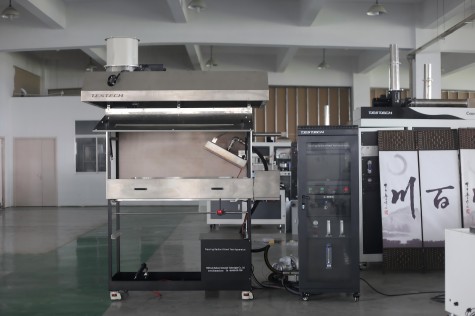News Center
The difference of ISO 9239, ASTM E648, NFPA 253 and ASTM D 2859 for flooring fire resistance properties
views:3213
Release time:3213
ISO 9239, ASTM E648, NFPA 253 and ASTM D 2859 are standards with different scope of application and test methods in the field of fire testing and material safety, and there exists a certain relationship between them, but they are not completely equivalent or alternative.
ISO 9239
Scope of application: ISO 9239 deals with the testing of floor coverings for their response to fire, in particular the determination of their burning behavior using the radiant heat source method. It is applicable to many types of flooring materials, such as wood flooring, plastic wood flooring, rubber flooring, all types of carpets, etc.
Scope of Application: ASTM E648 is a standard published by the American Society for Testing and Materials (ASTM) for determining the fire progression of flooring systems (such as panels, tiles and coverings) when exposed to radiant heat sources.
Test Method: The standard includes steps for specimen preparation, test rig setup, ignition testing and data analysis to evaluate the performance of flooring materials by calculating the critical heat radiation.
Benchmarking Relationship: ASTM E648 is similar to ISO 9239 in terms of test objectives, both focusing on the combustion performance of flooring materials, but the test methods and specifications may differ. In some cases, the two standards may be referenced to each other or used as complements.
NFPA 253
Scope of Application: NFPA 253 is a standard issued by the National Fire Protection Association (NFPA), specifically for critical radiant flux testing of floor coverings, also using the radiant heat source method.
Benchmarking: NFPA 253 has some overlap with ISO 9239 and ASTM E648 in terms of test methodology and application areas, both of which assess the performance of floor coverings in a fire. However, NFPA 253 may be more focused on evaluating performance in actual fire scenarios and contains specific grading requirements.
ASTM D 2859
Scope: ASTM D 2859 addresses fire testing of textile floor coverings and describes a test method for determining the flammability of finished textile floor coverings when exposed to an ignition source under controlled laboratory conditions.
Benchmarking: ASTM D 2859 is more focused on evaluating the fire performance of textile floor coverings than ISO 9239, ASTM E648, and NFPA 253. While the test methods may differ, they are all designed to ensure the safety and reliability of the material in a fire.
In summary, ISO 9239, ASTM E648, NFPA 253 and ASTM D 2859 have their own characteristics and scope of application in the field of fire testing and material safety. There exists a certain benchmarking relationship between them, but they are not completely equivalent or alternative. In practical application, the appropriate test standard should be selected for evaluation according to specific needs and material types.
ISO 9239
Scope of application: ISO 9239 deals with the testing of floor coverings for their response to fire, in particular the determination of their burning behavior using the radiant heat source method. It is applicable to many types of flooring materials, such as wood flooring, plastic wood flooring, rubber flooring, all types of carpets, etc.
Content of the standard: ISO 9239 consists of several parts, of which ISO 9239-1 is the most commonly used part for the determination of the combustion behavior of floor coverings under the action of a radiant heat source.

Scope of Application: ASTM E648 is a standard published by the American Society for Testing and Materials (ASTM) for determining the fire progression of flooring systems (such as panels, tiles and coverings) when exposed to radiant heat sources.
Test Method: The standard includes steps for specimen preparation, test rig setup, ignition testing and data analysis to evaluate the performance of flooring materials by calculating the critical heat radiation.
Benchmarking Relationship: ASTM E648 is similar to ISO 9239 in terms of test objectives, both focusing on the combustion performance of flooring materials, but the test methods and specifications may differ. In some cases, the two standards may be referenced to each other or used as complements.
NFPA 253
Scope of Application: NFPA 253 is a standard issued by the National Fire Protection Association (NFPA), specifically for critical radiant flux testing of floor coverings, also using the radiant heat source method.
Benchmarking: NFPA 253 has some overlap with ISO 9239 and ASTM E648 in terms of test methodology and application areas, both of which assess the performance of floor coverings in a fire. However, NFPA 253 may be more focused on evaluating performance in actual fire scenarios and contains specific grading requirements.
ASTM D 2859
Scope: ASTM D 2859 addresses fire testing of textile floor coverings and describes a test method for determining the flammability of finished textile floor coverings when exposed to an ignition source under controlled laboratory conditions.
Benchmarking: ASTM D 2859 is more focused on evaluating the fire performance of textile floor coverings than ISO 9239, ASTM E648, and NFPA 253. While the test methods may differ, they are all designed to ensure the safety and reliability of the material in a fire.
In summary, ISO 9239, ASTM E648, NFPA 253 and ASTM D 2859 have their own characteristics and scope of application in the field of fire testing and material safety. There exists a certain benchmarking relationship between them, but they are not completely equivalent or alternative. In practical application, the appropriate test standard should be selected for evaluation according to specific needs and material types.





